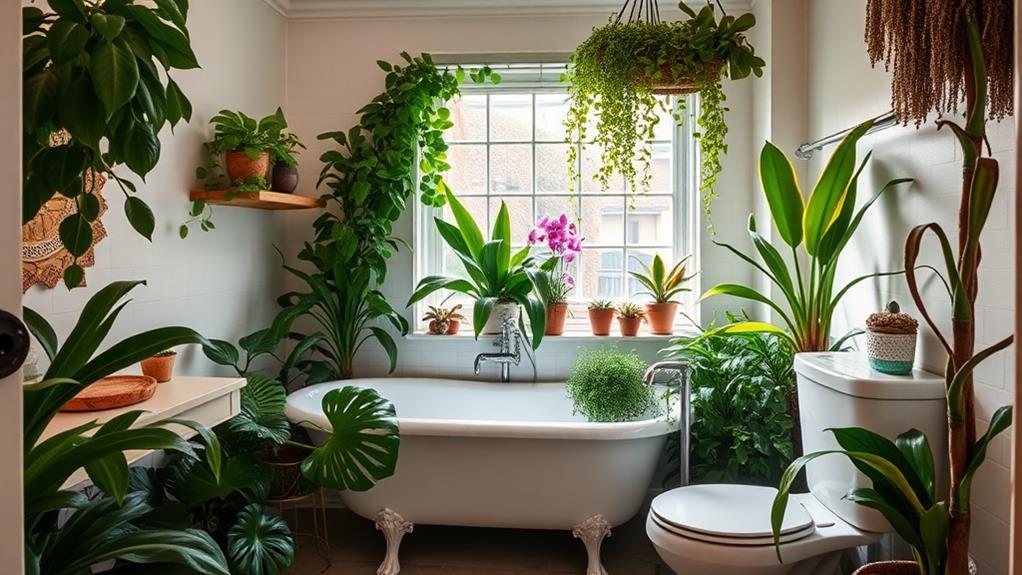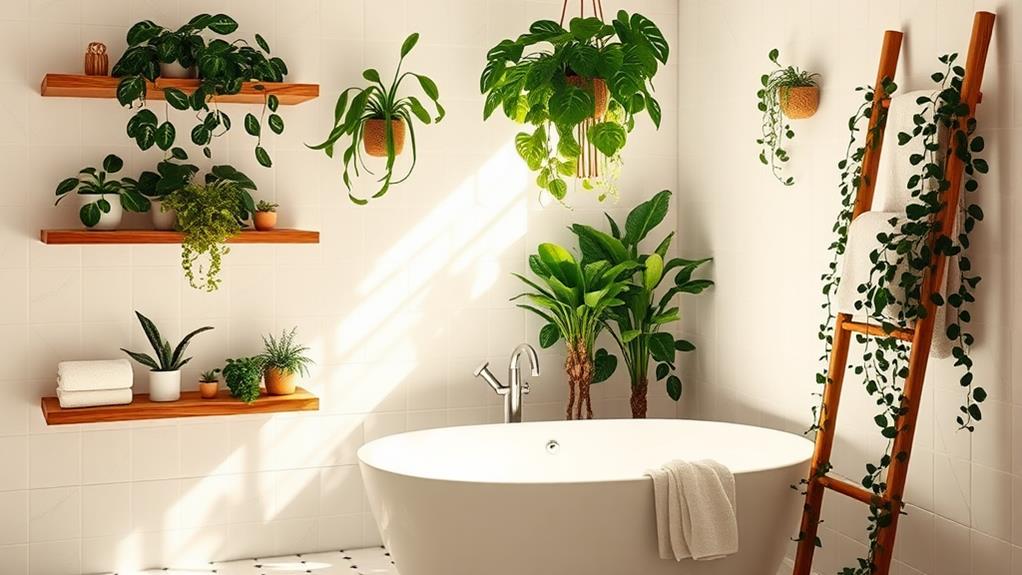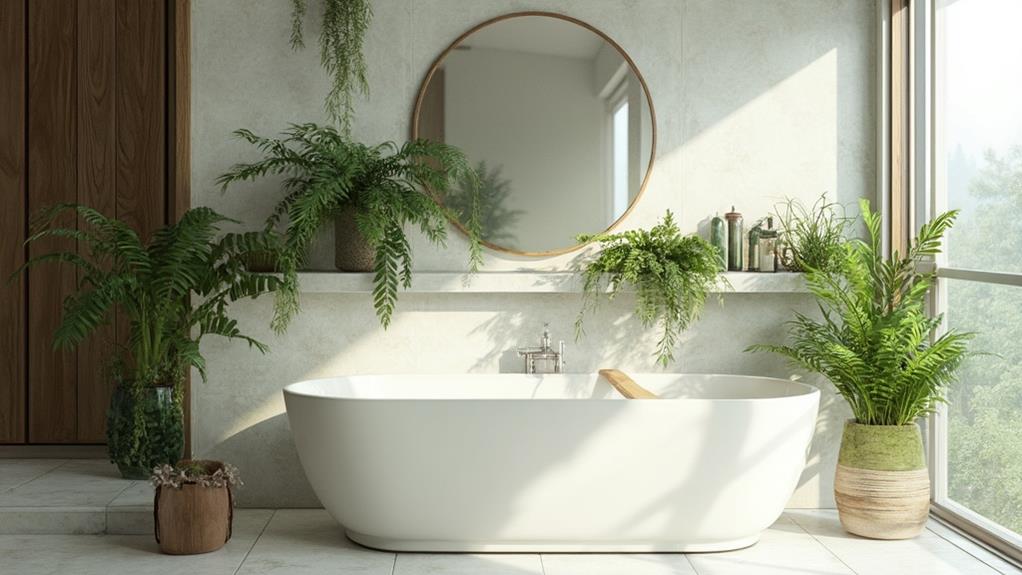Incorporating plants into your bathroom can transform it into a spa-like retreat while offering numerous benefits. You'll enjoy improved air quality, regulated humidity levels, and a mood-boosting atmosphere. Choose moisture-loving plants that thrive in low to moderate light, such as snake plants, spider plants, Boston ferns, peace lilies, and aloe vera. Position them near windows or use grow lights for optimal growth. Get creative with macramé holders, floating shelves, or repurposed fixtures to display your green friends. With proper care and placement, you can overcome common challenges like low light and excess moisture. Discover how these leafy additions can turn your bathroom into a lush, tranquil sanctuary.
Benefits of Bathroom Plants

Bathroom greenery offers more than just aesthetic appeal. By adding plants to your bathroom, you're creating a spa-like atmosphere that can help you relax and unwind. Plants naturally purify the air, removing toxins and improving overall air quality. This is particularly beneficial in bathrooms, where humidity and chemical cleaning products can lead to poor air quality.
Plants also regulate humidity levels, which can prevent mold and mildew growth in your bathroom. They absorb excess moisture through their leaves, helping to maintain a balanced environment. Additionally, some plants can even reduce bathroom odors naturally.
Incorporating greenery into your bathroom can boost your mood and reduce stress. Studies have shown that being around plants can lower blood pressure and heart rate, promoting a sense of calm and well-being. Plants can also enhance your focus and creativity, making your morning routine more enjoyable and productive.
Lastly, bathroom plants can add a touch of nature to an otherwise sterile space, creating a more inviting and visually appealing environment. They can soften harsh lines and add texture, making your bathroom feel more like a personal oasis.
Choosing the Right Plants
When selecting plants for your bathroom, it's crucial to consider the unique environment they'll be living in. Bathrooms typically have high humidity, fluctuating temperatures, and limited natural light. These factors significantly influence which plants will thrive in this space.
Opt for moisture-loving plants that can tolerate low to moderate light conditions. Some excellent choices include ferns, such as the Boston fern or bird's nest fern, which thrive in humid environments. Peace lilies and snake plants are also great options, as they're low-maintenance and can adapt to various light levels.
If your bathroom has a window, you might consider hanging plants like pothos or spider plants. These trailing varieties add visual interest and can help purify the air. For smaller spaces, air plants or small succulents can be ideal, as they require minimal care and can be placed on shelves or in wall-mounted planters.
Remember to consider the size of your bathroom when choosing plants. Larger bathrooms can accommodate floor-standing plants like bamboo or monstera, while compact spaces might benefit from smaller, tabletop varieties. Always ensure proper drainage to prevent water damage to your bathroom surfaces.
Top Bathroom-Friendly Plant Species

For optimal bathroom greenery, consider these top plant species that thrive in humid, low-light conditions:
- Snake Plant (Sansevieria): It's low-maintenance, purifies air, and tolerates low light.
- Spider Plant (Chlorophytum comosum): This adaptable plant removes toxins and grows well in hanging baskets.
- Boston Fern (Nephrolepis exaltata): It thrives in high humidity and adds a lush, tropical feel.
- Peace Lily (Spathiphyllum): Known for its air-purifying qualities, it also tolerates low light.
- Aloe Vera: This succulent prefers brighter bathrooms and offers medicinal benefits.
- Bamboo (Dracaena braunii): It's easy to care for and believed to bring good luck.
- English Ivy (Hedera helix): An excellent air purifier that can be grown in hanging baskets.
- Orchids: Many varieties thrive in bathroom humidity and add elegance.
- Pothos (Epipremnum aureum): A versatile, low-maintenance vine that purifies air.
- Chinese Evergreen (Aglaonema): This hardy plant tolerates various light conditions and humidity levels.
When selecting these plants, consider your bathroom's specific light and space conditions. Ensure proper drainage to prevent water damage, and rotate plants occasionally for even growth.
Placement and Care Tips
Strategically placing your bathroom plants and providing proper care is crucial for their longevity and visual appeal. For optimal growth, position your plants near windows to ensure they receive adequate natural light. If your bathroom lacks windows, consider using artificial grow lights to supplement their light needs.
When it comes to placement, utilize vertical space by hanging plants from the ceiling or installing wall-mounted planters. This not only saves floor space but also adds visual interest to your bathroom. Place smaller plants on windowsills, shelves, or countertops to create a cohesive look throughout the room.
To care for your bathroom plants, maintain proper humidity levels by misting them regularly or using a pebble tray filled with water. Ensure good air circulation to prevent mold growth, and avoid overwatering by allowing the soil to dry between waterings. Use well-draining potting mix and containers with drainage holes to prevent root rot.
Regularly clean your plants' leaves to remove dust and improve their ability to photosynthesize. Trim dead or yellowing leaves to promote healthy growth and maintain an attractive appearance. By following these placement and care tips, you'll create a thriving green oasis in your bathroom.
Creative Display Ideas

Now that you've mastered the basics of plant placement and care, it's time to explore creative display ideas that'll transform your bathroom into a green sanctuary. Consider hanging macramé plant holders from the ceiling or shower rod to create a cascading effect with trailing plants like pothos or string of pearls. Install floating shelves above your toilet or sink to display small potted plants, creating a mini vertical garden.
For a unique touch, repurpose vintage bathroom fixtures as planters. An old claw-foot tub or sink can become a stunning centerpiece filled with lush ferns or tropical plants. Use ladder shelves to create a tiered display of various plant sizes and species. Don't forget about wall-mounted options like living walls or magnetic planters that can adhere to tile surfaces.
Incorporate plants into your existing decor by placing them in decorative baskets or wrapping pots in colorful fabric. For a spa-like atmosphere, arrange plants around your bathtub or create a green privacy screen near windows. Remember to mix and match different plant heights, textures, and colors to create visual interest and depth in your bathroom oasis.
Overcoming Common Challenges
Persistence is key when tackling the common challenges of keeping plants in your bathroom. Low light conditions can be addressed by choosing shade-tolerant species or using grow lights. If your bathroom lacks natural light, consider rotating plants between the bathroom and brighter areas of your home.
High humidity can lead to mold growth on soil. Combat this by improving air circulation with a small fan or by leaving the bathroom door open when possible. Use well-draining potting mix and pots with drainage holes to prevent waterlogging. To avoid overwatering, always check the soil moisture before adding water.
Limited space can be overcome with creative solutions. Use hanging planters, wall-mounted pots, or narrow shelving units to maximize vertical space. For countertop areas, opt for compact species or miniature varieties.
Temperature fluctuations from hot showers can stress some plants. Place sensitive species away from direct shower spray and drafts from windows or vents. If your bathroom gets cold at night, choose hardy plants that can tolerate temperature changes or move them to a warmer spot temporarily.
Conclusion
You're now ready to transform your bathroom into a lush, green oasis. While you might worry about maintenance, many bathroom-friendly plants are actually low-maintenance. They'll thrive in the humid environment, purify the air, and elevate your space's aesthetic. Don't let limited room deter you; there are plenty of compact options and creative display solutions. By incorporating plants, you'll create a calming sanctuary that enhances your daily routines and connects you with nature, even in the smallest of spaces.

